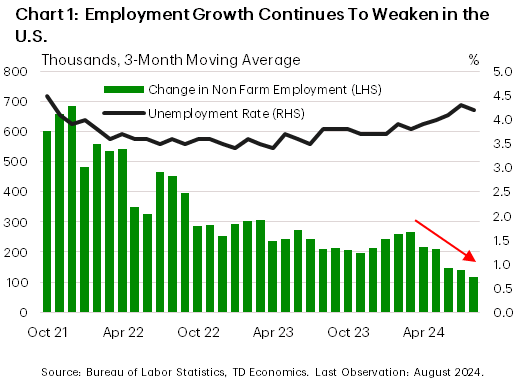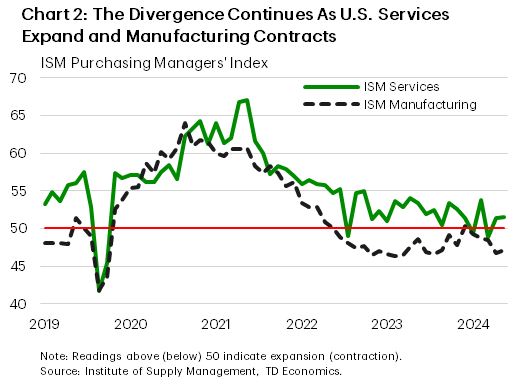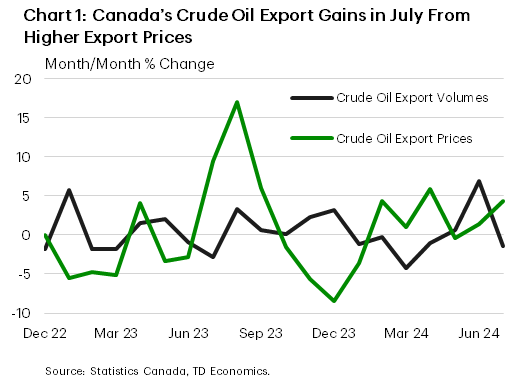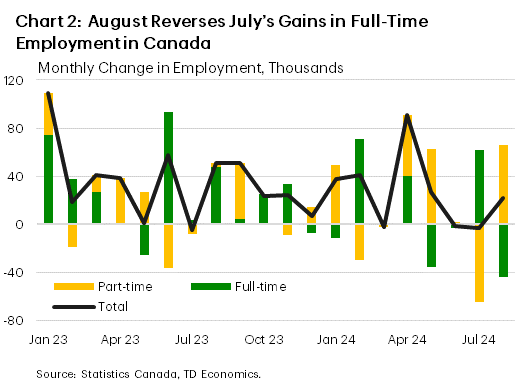U.S. Highlights
- The U.S. added fewer jobs than expected in August, even as wage growth accelerated, and the unemployment rate edged down. Additionally, JOLTS data pointed to lower job openings, suggesting that the U.S. labor market continued to cool.
- Fed Governor Williams stated that the time had come for less restrictive monetary policy but remained mum on the possible size of any cut. Governor Waller, however, suggested he favored starting carefully.
- Manufacturing activity continued to contract in August, with demand easing. However, the services sector, continued to chug along as it has for much of this year.
Canadian Highlights
- There were no surprises from the Bank of Canada this week, as they proceeded with another rate cut this week. We expect two more rate cuts before the end of the year.
- Employment data for August showed modest job gains, but the details of the report indicate cooling in the labour market.
- Canada recorded a trade surplus in July, leaving net trade tracking to add modestly to third quarter growth in Canada.
U.S. – With Employment Slowing, The Time to Cut is Here
In a holiday shortened week, the labor market took center stage. Both the Job Opening and Labor Turnover Survey (JOLTS) and employment report were on the calendar. Given the Fed’s recent heighten focus on the second leg of its dual mandate – to promote maximum employment – the reports carried larger than usual significance. Notably, they provided a last look at top-tier labor market data before the Fed’s meeting on September 18th. Markets were generally down throughout the week. This morning’s employment report extended that trend as 10-year bond yields edged lower relative to last week’s close (-0.22 percentage points) and the S&P500 also dipped lower (-3.4%), as of the time of writing.
The increase in August’s payroll growth came in lower than anticipated and on a three-month basis, continued to head lower (Chart 1). Additionally, the figures for the prior two months were revised down. Despite this, there was some good news – the unemployment rate ticked down and annual growth in average hourly earnings edged up. Today’s payrolls report was a mixed bag, but overall, adds to the thesis that the labour market has eased off the gas. In a statement by Fed Governor Williams, following release of the report, he was clear in his believe that it was now appropriate to dial back policy restrictiveness. Further, speaking after the jobs data, Governor Waller pointed to starting rate cuts “carefully”, but was open to moving faster if the data warrant it.
In another sign of a cooling labor market, the more backward-looking JOLTS report revealed that job openings fell more than anticipated in July to 7.7 million. This marked the lowest level in more than three years. Additionally, the job openings to unemployed workers ratio declined to 1.1 from a high of 2 in early-2022. The job separation rate also ticked up in July after a dip in June, though it still remains relatively low. Overall, the JOLTS data suggests that the pandemic era of tightness in the labor market has receded and adds to the mounting evidence of cooling labor demand and a slowing economy.
On the production side, while the ISM Manufacturing Index managed to edge up in August, it remained in contraction territory for the fifth consecutive month and came in lower than analysts’ expectations. The sector continued to experience weakness in demand as both the new orders and new export orders indexes slid deeper into contraction. The ongoing weakness in the sector rekindled some concerns over the health of the economy. On the services side, however, things were a bit better, with the ISM Services Index coming in at 51.5 in August, up just slightly from 51.4 in July. Overall, the services sector continues to hold its ground, offsetting much of the weakness evident in the manufacturing sector (Chart 2).
With the employment numbers now a known variable, the Fed’s attention will be focused on the inflation data on tap for release next week. Barring any unforeseen flare-ups, all roads seem to lead to a quarter-point rate cut at the September meeting.
Canada – Signs Point to Continued Rate Cuts
The Bank of Canada’s interest rate decision on Wednesday was front and centre to start off September. As widely expected, the Bank of Canada reduced its benchmark rate by a quarter of a percent, in line with our expectation. Their statement recognized what we have been seeing in the data since their July rate reduction – economic activity has been softening, the labour market has been cooling, and inflation is slowing further towards its target. While the Bank of Canada has maintained a measured tone around inflation, we expect the weakening trends in the labour market and growth to be their focus in upcoming meetings. We continue to expect another 175 basis points in cuts through the end of next year, at a pace of a quarter point per meeting.
July’s trade data on Wednesday also showed some hints of softening that underscore the need for the Bank of Canada to continue on its rate reduction path. While Canada recorded a trade surplus for the month, this was on the back of declines in both import and export volumes, meaning that the surplus was driven by a combination of higher prices and greater weakness in imports than exports. Weakness in imports is often just another symptom of softening demand in the economy. There may be some brighter notes in the coming months’ trade data. While crude oil exports increased in July due to higher prices and a modest decline in volumes, we expect that volumes should be boosted in the coming months due to shipments from the newly operational Trans Mountain Pipeline (Chart 1). This is a spot to look for growth in next month’s report.
On Wednesday, the Bank of Canda noted that the labour market had continued to slow, with little change in employment in recent months. At the time, the data for June and July showed close to no monthly changes in total employment. The August data, released today, does complicate that story somewhat, showing a gain of 22k new positions – though this is not a statistically significant increase given the high volatility of this report. Also of note, all of the net new gains in employment in August were in part-time employment (Chart 2). More than that, the increases in full-time employment from the July data were reversed. Notwithstanding the relatively high volatility of the employment data, these are signs of a cooling labour market. Adding to this, labour force growth outpaced employment growth, leading to the unemployment rate to tick up to 6.6 percent. Wage growth moderated somewhat, though still rising at a healthy clip – average hourly wages in August were still up 5% from a year prior, compared to the long-run average of around 3%. Wage growth this high does mean that concerns about inflation are still relevant.
The combination of moderating wage growth, rising unemployment, and falling full-time employment is a clear signal that the labour market is cooling. When expectations for interest rates are as firmly entrenched as they are now, the main thing to look for is any signal that might upset those expectations – and we saw nothing to upset the apple cart this week. This week’s data were not game changers, leaving a clear case for the Bank of Canada to continue reducing interest rates.

















